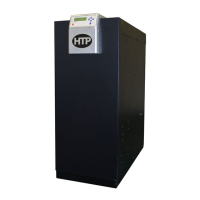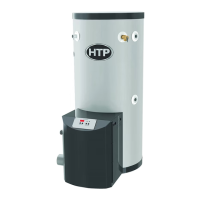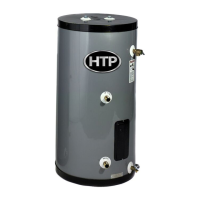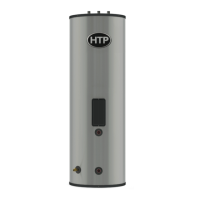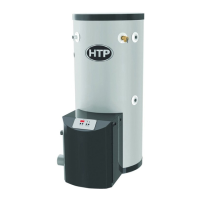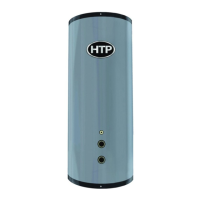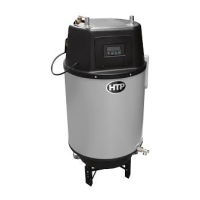lp-608 Rev. 000 Rel. 001 Date 3.15.18
14
STEP #1 - Turn o power to the water heater. Use a Phillips Head
screwdriver to remove wires connecting the element to the thermostat.
Failure to disconnect the power from the water heater before
attempting heating element replacement will result in property
damage, severe personal injury, or death due to electric shock.
STEP #2 - Run hot water at a faucet in the system. When it runs cold,
shut o the faucet. Then shut o water at the main cold water inlet or,
if possible, valve o the water heater from the system. Drain the water
from the system, or just the water heater if it can be isolated from the
system.
Completely drain the water heater before removing and replacing a
heating element or elements. Failure to do so will result in a leakage
of water and property damage, and could result in moderate to
severe personal injury or death.
Water drained from the water heater may be scalding hot. Take care
to avoid scalding. Wear gloves and safety glasses, and direct water to
a safe drainage location. Failure to comply with this warning could
result in property damage, severe personal injury, or death.
DO NOT replace heating element with a generic heating element.
Only HTP heating elements are approved for use with this water
heater. Failure to follow this warning will result in premature product
failure and VOID the warranty.
Step #3 - Remove the element with a 1 1/2” socket wrench or element
tool.
Step #4 - Inspect the removed element. Determine whether the
replacement element will need a square or circular gasket and washer.
Failure to shut o the heater when draining may damage the
heating elements. Operating a partially lled / empty water
heater could lead to damage from “dry-ring”. Failures due to such
damage ARE NOT covered by warranty.
Figure 9 - Heating Element Detail
NOTE: Repeat Steps 3 - 6 as Necessary for Multiple Elements
Step #8 - Open the main cold water inlet. If the water heater has been
isolated from the system, open the valves. Rell the tank with cold
water. Open a hot water faucet high in the system to bleed any air
pressure from the system. Water will ow freely when air is completely
bled.
When lling the water heater, open a hot water tap to release air
in the tank and piping. The tank must be full of water before the
heater is turned on. Failure to ensure the water heater is full before
turning it on will result in damage to the water heater, and could
result in property damage, serious personal injury, or death. Such
damages ARE NOT covered by water heater warranty.
Step #9 - Pressure check the tank for leaks around element. If no
leaks are found, connect wires from the element to the thermostat.
Step #10 - Turn power back on to the water heater.
Failure to rell the tank before restoring power to the water
heater will result in damage to the heating elements and property
damage. Such damages ARE NOT covered by warranty.
Part 7 - Maintenance
Considerations
• To avoid electric shock, disconnect electrical supply before
performing maintenance.
• To avoid severe burns, allow heater to cool before performing
maintenance.
NOTE: In addition to the routine maintenance detailed in this manual,
this water heater should be inspected annually by a qualied service
technician to assure that all the equipment is operating safely and
eciently. The owner should make necessary arrangements with a
qualied heating contractor for periodic maintenance of the heater.
The qualied installer / service technician must also inform the owner
that lack of proper care and maintenance may result in a hazardous
condition, premature heater failure, and void the warranty.
Routine preventative maintenance ensure the water heater operates
safely and eciently over its service life. The Owner / User may
perform the maintenance activities described below.
Monthly (Every two weeks in hard water locations)
It is recommended that a few quarts of water be drained from the
heater. This will ush sediment deposits from the bottom of the
heater and lengthen the heater’s service life. Turn o power to
the heater during ushing operation, so the elements will not be
damaged.
To ush the tank, attach a hose to the eld installed drain valve.
Close the cold water supply line shut-o valve. Open the drain valve
and hot water faucet(s) to vent heater while draining. Direct the ow
of water to a drain or bucket where it will not cause damage.
Flush until water runs clear to complete this operation. Close drain
valve and reopen the supply line shut-o valve. Close the hot water
faucet(s) once all air has been bled from the system (when water
runs freely). Make certain that the heater is completely full of water
before restoring power.
Water drained from the water heater may be scalding hot. Take
care to avoid scalding. Wear gloves and safety glasses, and direct
water to a safe drainage location. It is recommended to turn
power o to the water heater and run water at a hot water faucet
until it cools BEFORE draining water from the heater. Failure to
comply with this warning could result in property damage, severe
personal injury, or death.
Step #5 - Ensure thread and opening are completely free of debris. Use
a nylon brush to clear away any debris.
Step #6 - Put a small amount of NSF approved lubricant and sealant
on the appropriate gasket and/or washer for the installation. Put the
gasket and/or washer on the element.
Step #7 - Screw the element clockwise into the tank, and tighten with
the 1 1/2” socket wrench or element tool. Use the appropriate gasket
for the water heater (two are included in the kit), and ensure the gasket
seats properly.
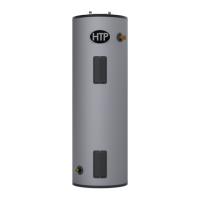
